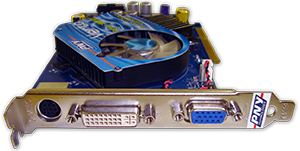Understanding the Video Card

Computer hardware can be a pretty complicated subject, even to those who spend lots of time working with computers. No one can blame you for feeling overwhelmed when trying to keep up with the latest products and features, and it doesn't help that many components seem to become obsolete overnight. If you're a gamer new to PC hardware, or you've just been out of the loop for a while, this guide will cover one component close to your computer's heart: the video card. After reading this article, you will know the function of a video card in your computer, and the main features of a video card: the interface by which it communicates with the computer, the core of the video card, and the video card's RAM.
If the CPU is the brain of a computer, the video card is its imagination. Really, anything the CPU can think up, the video card can beautifully recreate in 3D imagery. A video card's function is to take information from the CPU and convert it to an image, and then send that image to your monitor. Without video cards, modern gaming would be impossible. While a CPU can render simple 3D images, the video card excels at drawing complex scenes very fast. A modern video card can render a 1080p scene at 60 frames-per-second. That means that it calculates and draws over 2 million individual pixels 60 times every second!
Video cards communicate with your computer through a few possible interfaces. Older video cards used the PCI bus, or the AGP (Accelerated Graphics Port) bus, but modern cards almost exclusively use the PCI-express interface. PCI-express offers greater bandwidth over the older interfaces, which means that the video card can communicate with the CPU much faster. There are two versions of the PCI-express interface: version 1.1 and version 2.0. Newer cards are meant to run in PCI-express 2.0 slots, but the interface is backwards compatible, which allows PCI-express 2.0 cards to run in version 1.1 slots and vice-versa.
One important aspect of the video card is how much RAM it has. RAM helps a video card by allowing it to hold image data in memory, rather than having to recalculate it every frame. More RAM is usually a good thing, but you also have to consider what type of RAM is used. Modern video cards typically use 3 types of RAM: DDR2, GDDR3, and GDDR5. DDR2 is the slowest, and GDDR5 is the fastest. When comparing a video card with a large amount of slower RAM to a smaller amount of faster RAM, the card with the faster RAM will usually perform better.
The heart of a video card is it's core; that is, the chip that performs all the calculations and processing. A video card's core is made of many individual work units called “stream processors”. When the video card is sent information from the CPU to draw an 3D image, that information is distributed among the card's stream processors to calculate that image. More stream processors allow more calculations to be performed at the same time, so a high stream processor count is a desirable feature on a video card.
We've covered the function of a video card, and the card's major features: the RAM, the core, and the interface. The understanding of these features allows you to make informed decisions when comparing and choosing a new video card.